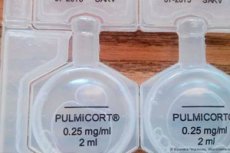Medical expert of the article
New publications
Inhalation with pulmicort through a nebulizer: how to do it correctly?
Last reviewed: 04.07.2025

All iLive content is medically reviewed or fact checked to ensure as much factual accuracy as possible.
We have strict sourcing guidelines and only link to reputable media sites, academic research institutions and, whenever possible, medically peer reviewed studies. Note that the numbers in parentheses ([1], [2], etc.) are clickable links to these studies.
If you feel that any of our content is inaccurate, out-of-date, or otherwise questionable, please select it and press Ctrl + Enter.

One of the most popular and effective methods of inhalation is the use of a nebulizer. This device converts the medicine into an aerosol, which during inhalation comes into contact with almost the entire surface of the affected mucous membrane. Due to this, the active components act directly on the respiratory tract, bypassing the passage through the stomach.
Pulmicort for inhalation with a nebulizer is used for bronchial asthma, COPD, upper respiratory tract diseases, allergic reactions, both in children and adults. The nebulizer provides a continuous supply of medicine, due to which there is no need for deep inhalations and exhalations.
The procedures are carried out in compliance with the following rules:
- The drug solution is mixed with saline or other drugs in the proportions prescribed by the doctor.
- Inhalation can be started 1-2 hours after meals and physical activity.
- You must not talk during the procedure.
- The patient should wear clothing that does not restrict movement or make breathing difficult.
- For diseases of the nasopharynx, nose or paranasal sinuses, GCS is inhaled through a mask.
- After inhalation, rinse your mouth with warm water and wash your face thoroughly.
- You can eat and talk 15-20 minutes after the procedure.
- Smoking is contraindicated during inhalation treatment.
Inhalations with a nebulizer can be performed up to 3 times a day. Before treatment, it should be taken into account that this method is contraindicated for patients with a tendency to nosebleeds, cardiovascular diseases, purulent tonsillitis and respiratory pathologies.
How to dilute Pulmicort for inhalation?
Pulmicort is intended for inhalation administration using a nebulizer. GCS in its pure form can only be used for patients over 12 years of age, provided that a single dose is no more than 2 ml.
For children under 12 years of age, Pulmicort is diluted with saline. The proportions are determined by the attending physician, assessing the patient's condition and age. Most often, children are prescribed a dilution in a 1:1 ratio or 1 part of the drug to 2 parts of sodium chloride.
In case of complex treatment, additional preparations for diluting GCS may be prescribed. The diluted solution must be used within 30-40 minutes after preparation.
 [ 1 ]
[ 1 ]
Pulmicort with saline solution for inhalation
To prepare a solution for inhalation using a nebulizer, Pulmicort is diluted with saline. The proportions of the drugs are determined by the attending physician, individually for each patient. As a rule, the diluted suspension is prescribed for the treatment of patients under 12 years of age.
Recommended ratio of Pulmicort and saline solution:
- For 0.25 mg you need to take 1 ml of sodium chloride.
- For 0.5 mg – 2 ml.
- For 0.75 ml – 1 ml sodium chloride.
The prepared solution should be used as directed within 30 minutes, so there is no need to prepare the suspension in reserve. Inhalations are performed 2-4 times a day. The duration of therapy is at least 5-7 days.
 [ 2 ], [ 3 ], [ 4 ], [ 5 ], [ 6 ]
[ 2 ], [ 3 ], [ 4 ], [ 5 ], [ 6 ]
Pulmicort with berodual for inhalation
Very often, for the complex treatment of bronchopulmonary diseases, patients are prescribed inhalations with Pulmicort and Berodual. Berodual is a bronchodilator, and Pulmicort is a glucocorticosteroid. Both drugs effectively relieve bronchial spasms, eliminate asthma attacks, and have an anti-inflammatory effect.
The simultaneous use of both drugs allows for an immediate therapeutic effect and a reduction in the severity of painful symptoms.
Main indications for combined inhalations:
- Obstructive bronchitis.
- Pneumonia.
- Laryngitis.
- Tracheitis.
- Chronic obstructive pulmonary disease and other bronchospastic reactions.
The therapeutic effect occurs immediately and lasts for 2-3 hours. Both drugs are potent medications and are available only on prescription.

